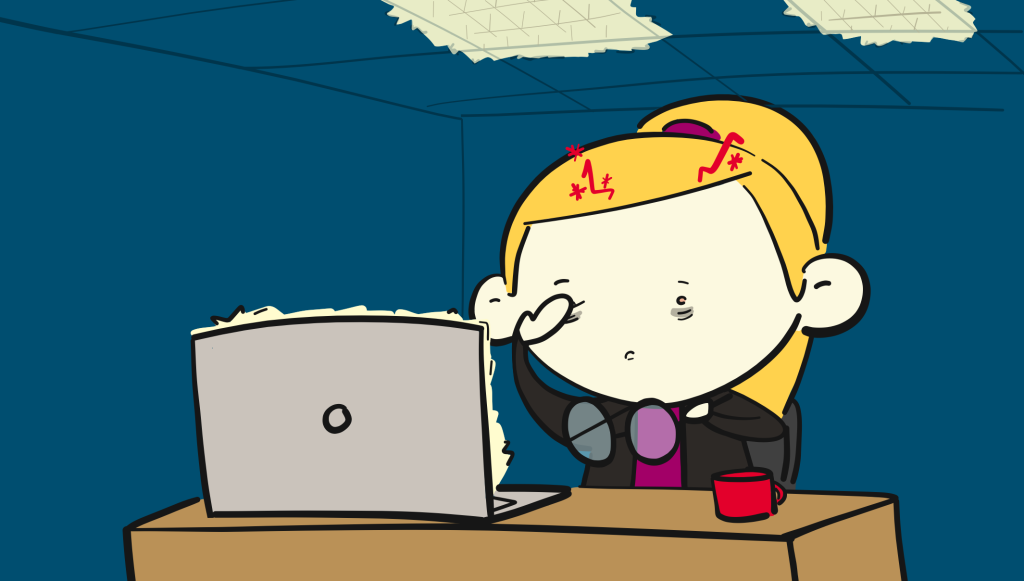The proper type of lighting in an office is crucial. If you’ve ever gotten a headache at work from straining your eyes due to poor lighting, you are not alone. According to the American Society of Interior Design, 68 percent of employees complain about the lighting in their offices.
Office lighting should be one of the very first things taken into consideration during the office design phase. Not only can proper office lighting contribute to an employee’s health, positive attitude and productivity but it can also save money, so the company can focus on the continued well-being of its employees.
Artificial, harsh lights don’t boost health and productivity. In fact, just the opposite. Artificial lighting refers to any forms of light that are not considered “natural light” – lamps, overhead light fixtures, etc. While some types of artificial lighting are beneficial, many offices use forms of artificial lighting that are either too harsh or too dim. Things to consider when choosing office lighting are:
Health problems from poor office lighting
Harsh and dim forms of office lighting can contribute to the following health problems:
-
Migraines and headaches
Harsh overhead lighting is one of the causes of headaches and migraines. When a headache or migraine is triggered during a work day, this can lead to a level of discomfort that will deter the employee from feeling productive or motivated. If the migraine requires an employee to seek medical attention, the company faces the potential absence of a perfectly competent employee.
-
Poor sleep
Everyone has a circadian rhythm, an internal clock triggered by lighting that your body responds to throughout the day. Our circadian rhythm is the reason natural light is necessary – our bodies are attuned to the rhythms of natural, outdoor light, so recreating this in the workplace during office hours will keep employees energized and motivated. As a result, your employee’s quality of sleep at night will benefit, resulting in longer, more restful nights and more productive days.
-
Drowsiness and fatigue
Oftentimes, when employees feel tired or fatigued at work, they will turn to distractions to perk them up. This could mean browsing the internet for things unrelated to work or overly socializing. An alternative lighting system could avoid these common symptoms of tiredness, and increase an employee’s motivation to continue doing their job productively.
-
Tired, strained eyes
When an employee is staring at the bright screen of a computer all day, the last thing they want is additional eye strain from a poorly lit office. The combination of lighting from a computer screen and the ripples from harsh lighting can cause poor concentration and ultimately, reduced productivity.
Natural light contributes to overall satisfaction
Not only does natural light in the office help our eyesight but it also boosts mood, energy level, happiness, and promotes a general willingness to simply show up to work.
One study cites that 75.8 percent of employees find natural light important to them, yet only 56.9 percent are satisfied with their current workplace arrangement. If the statistics aren’t enough to support the claim that natural light is best, it is also shown to diminish the effects of seasonal affective disorder. In addition, choosing natural light is inherently a less expensive company alternative.
Lighting options provide more control
More lighting options in the office provide employees with a feeling of comfort and control over their surroundings. If an employee has the option to work in a pleasant environment, this comfort level will spill over into the quality of their work. If a company installs lights with dimmers on it, an employee can decide whether or not they prefer dimmer or brighter lighting, depending on personal preference and the project they are working on. This allows them to control how they want to work and in what environment.
Different types of office lighting to achieve ergonomic success
The different types of lighting needed in an office vary depending on the room or area and the type of work that will be done there.
The main types of lighting are:
-
Ambient lighting
Places like conference rooms, hallways, and reception areas require brighter lighting to illuminate the entire area. This is referred to as ambient lighting, achieved with a larger lighting installation, specifically with overhead light fixtures. Many offices use fluorescent lighting for this purpose. While less expensive upfront, these can cause significant long-term negative effects on health and productivity. Alternatively, try incandescent lighting, or if fluorescent lighting is ever-present, consider using natural light exposure to combat the negative effects of fluorescent lights.
-
Accent/focal lighting
Whereas task lighting is helpful for illuminating task-work, accent/focal lighting is useful for illuminating something you want on display. For example, maybe you work for an architectural firm and there is a miniature prototype of a building you want to shed light upon for a client presentation.
-
Task lighting
What happens when it’s a stormy day outside and there is very little natural light? Task lighting is a finer type of lighting used to illuminate a specific task over a larger surface area. Projects such as reading, writing, working with your hands, and cooking or sewing would benefit from this type of lighting. In order for it to be effective, the light should contrast with the rest of the space. This is where a brighter, focused light such as that from a desk lamp might come in.
Not all offices illuminate alike
Open concept office spaces with a lot of windows will require a fundamentally different type of lighting system over offices that don’t receive any natural light at all. In addition, understanding what certain rooms are designed for will help in selecting a lighting option. What happens in a conference room? Collaboration. Hence, a lot of light will be helpful. What about the breakroom? Go the softer lighting route. Cubicles? Well, these should receive more portable lighting options than offices.



